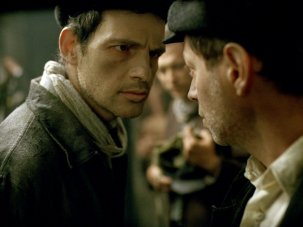The emotionally and intellectually fraught – and very public – debate about what can or cannot be depicted when recounting, or worse, reconstructing the Holocaust on film goes back at least as far as Gillo Pontecorvo’s Kapò (1960). For the scene in which Emmanuelle Riva’s camp inmate throws herself onto an electrified fence, and the camera tracks in to frame her body against the sky, Cahiers du cinéma critic (and later filmmaker) Jacques Rivette famously declared that whoever decided on such a stylised shot “is worthy of the most profound contempt.”
Time and again, an atrocity of such magnitude churns up these same questions: how can art talk about the unspeakable? How can it depict the unshowable? As another critic, the New Republic’s Stanley Kauffmann, wrote when reviewing Tim Blake Nelson’s Auschwitz-set The Grey Zone (2001), “The almost agonizing aspect of these films is that, after they fulfil their sheerly informational function, the only criterion left, as noted above, is aesthetic.” Thus, does Steven Spielberg’s Schindler’s List (1993), with its emotive, classical Hollywood style, honour its subject or somehow exploit it? Is Claude Lanzmann’s eyewitness testimony-led Shoah (1985), rejecting all archive material, the methodology all documentaries should follow, or does its unmatched reputation depend on its very uniqueness? Indeed, is the Holocaust itself somehow more sacred than other genocides, such that it requires special handling?
As acclaimed new Hungarian film Son of Saul opens, attracting rave reviews and multiple awards for its attempt to re-visualise the unimaginable horrors of existing inside a concentration camp, this video essay attempts to examine several different approaches to Holocaust films; and see whether cinema’s intrinsic quality – visions of light – can ever do justice to real-life experiences of such utter darkness.





